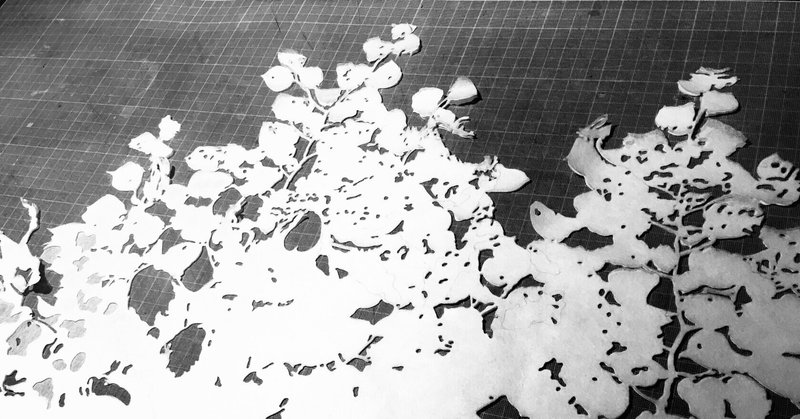
平家から継ぐ美意識
(English follows Japanese!)
TVアニメーション「平家物語」を観ておもしろかったので、古川日出男さん訳の原作を読み始めています。
TVアニメーション「平家物語」では、平家を見届け語り継ぐ立ち位置としてびわという少女が登場しますが、古川さん訳の「平家物語」では琵琶の演奏と共に語り口調で物語が進みます。
「我が一族はその昔下関の海賊で、なんやかんやあって海にいられなくなり逃げた先が中部地方の山間部。我らその末裔である。」という嘘だか誠だかわからぬ話を祖父から聞いたことがあり、「それって平家の可能性あるんじゃない、、、の?」なんてちょっとロマンを持って読んでいるので、古川さん訳の快活な物語の語り口の助けもあって「それで、それで平家はどうなるの?どうなったの?」と妙にグイグイ惹き込まれる感じがあります。
読み進めているのはまだ全体の1/3程度ですが、おもしろいなと思う箇所といえば、、、。
いろんなことを祈祷か占いで何とかしており、神仏の世界と人の生きる世界が隔てなく繋がっている印象があります。
ただ、「占い師は天文学にも精通している」との一文があり、当時なりのサイエンスだったのかもなあ、とも思います。2023年のサイエンスが、3000年代になってどんなふうに見られるかわかんないですもんね。
一方で、
「あらゆる物事はその妙を極めるとき、自然に感動が起こるのが道理なのです。」と普遍的な、現代にもそのまま通じる一文もあります。
読んでいると、変わるもの/変えるもの、変わらないもの/変えないもの を時代を越えて触れ、考えることで、自分の中でダイナミックに繋がってゆくものがあります。
さて。
平家栄華の中心人物であった平清盛。
この平清盛ら平家一門が、その繁栄を願って厳島神社に納めた「平家納経」という経巻(経巻:お経が書かれた巻物。全33巻。)があります。時代時代で模本が作られる中、原本は今も厳島神社に納められています。「豪華絢爛、贅の粋をきわめた経巻」と言われていますが、美しく飾り立てることは当時功徳とされており、そのギラギラとした言葉とはうらはらに、優美で、柔らかな色合いと線でとても品のある経巻と感じます。
平家納経が厳島神社に納められておよそ400年後の1602年、広島藩は福島正則の命により、その一部の修復が行われることになりました。ここで3巻分の表紙絵と見返絵(お経の先頭に描かれる絵)を担当したのが、まだ無名の俵屋宗達だったといわれています。
その後、俵屋宗達は、当時のアートディレクター的存在であった本阿弥光悦と共に版画と和歌の書による巻物を多く制作しています。
花卉摺絵新古今集和歌巻
サイズ:34.1×全長907cm
年代:桃山〜江戸(1600年代)
版画下絵:俵屋宗達
書:本阿弥光悦
出典:MOA MUSEUM OF ART
この優美さ、温かさ、少しばかりの寂しさと儚さ。絵と書の間に充満する祝福感。静かな感動。観る者に伝わる充足感!大好き。
平家、俵屋宗達、さらに尾形光琳、葛飾北斎へと続いた美意識は、1800年代にパリへ渡り印象派の作家たちにも受け継がれていったように思います。その後、科学革命とともに「美」の考え方も大きく変わり今日へとつながります。
私は、現代の私の視点でしか過去を想像できません。それでも。過去の作品に触れてみると、人が何を美しいと感じ、その美しさが人の心に何をもたらすのかは、そうそう変わらないんじゃないかな、と思うのです。
読みにきてくださってありがとうございます。
次回は3月6日、啓蟄の頃に更新します。
参考文献:
・「平家物語」古川日出男訳 日本文学全集09 河出書房新社
・「琳派ー俵屋宗達から田中一光へー」山種美術館(展覧会カタログ)
・「琳派芸術ー光悦・宗達から江戸琳派」出光美術館(展覧会カタログ)
・「風神雷神」上・下 柳広司作 講談社文庫
・MOA美術館 公式サイト
・「平家納経模本の世界ー益田本と大倉本ー」東京国立博物館 公式サイト
(大正時代に作られた模本と原本の比較展覧会の学芸員さんのブログです。俵屋宗達が担当した巻ではありませんが、平家納経がどのようなものなのかきれいな画像で見れるのでぜひ。)
Aesthetic Sense Inherited from the Heike
I watched the TV animation "The Tale of the Heike" and enjoyed it so much .
I have started reading Hideo Furukawa's translation of the original story.
In the animated TV animation "The Tale of the Heike," a young girl named Biwa appears as a witness to the Heike clan and a narrator.In Mr. Furukawa's translation of "The Tale of the Heike," the story is told in a narrative style with biwa accompaniment.
"
Our family was once pirates in Shimonoseki, but when we could no longer stay at sea, we fled to the mountains of the Chubu region. We are their descendants!" I have heard this story, which I do not know if it is a lie or not, from my grandfather.
I am reading this story with a romantic view, thinking, "Could I be a descendant of the Heike clan?"
The lively story-telling style of Mr. Furukawa's translation, made me wonder, "So, what happens to the Heike family? What happened to them? "
I am only about 1/3 of the way through the book, but I found some interesting parts.
I have the impression that the world of the Sprits and Buddha is connected to the world of human life without any separation between them.
However, there is a description that "fortune tellers are well versed in astronomy," which makes me wonder if it was science in its own way at that time.You never know how the science of 2023 will look like in the 3000s.
One the other hand,There is also a sentence that is universal and applicable even today: "When everything is at its peak, it is natural to be moved. Reading this book, I feel a dynamic connection within myself by touching and thinking about what changes and what does not change, and what does not change and what does not change, across the ages.
Now, let's look at the Heike family.
Taira no Kiyomori was a central figure in the prosperity of the Heike clan.
Heike Nokyo" is a sutra scroll (sutra scroll: a scroll containing sutras. 33 volumes in all.)Heike Nokyo is delivered to Itsukushima by Taira no Kiyomori, Shrine to pray for prosperity.While copies were made in different periods of time, the original scrolls are still housed at Itsukushima Shrine.
The sutra scrolls are said to be "gorgeous and extravagant, the height of luxury.The beautiful decoration was considered a virtue in those days, and contrary to the glaring words, the sutra scroll is graceful and elegant, with soft colors and lines.
In 1602, approximately 400 years after the Heike-no-Kyo Sutra was delivered to Itsukushima Shrine, a partial restoration of the scroll was ordered by Masanori Fukushima of the Hiroshima domain.
It is said that the person in charge of the cover art and the frontispiece (the picture at the top of the sutra) for the three volumes was the still-unknown Tawaraya Sotatsu.
Later, together with Honami Koetsu, who was an art director of the time, Tawaraya Sotatsu produced many scrolls with prints and waka poetry calligraphy.
(Watch YouTube!)
This elegance, warmth, and a bit of loneliness and transience. The sense of blessing that fills the space between the painting and the calligraphy. A quiet emotion. A sense of satisfaction that is conveyed to the viewer!
The aesthetic sense that continued from the Heike , Tawaraya Sotatsu to Ogata Korin , Katsushika Hokusai seems to have been passed on to the Impressionist artists in Paris in the 1800s. Later, with the scientific revolution, the idea of beauty changed drastically, leading us to today. I can only imagine the past from my present-day perspective. Even so. I think that what people find beautiful and what that beauty brings to their hearts will not change so much.
Thank you for coming to read this.
The next update will be on March 6, around the time of the Keichitsu
HANARASURI E SHIN KOKIN SHU WAKA MAKI
Size: 34.1 x 907 cm (total length)
Date: Momoyama - Edo (1600s)
Print underpainting: Tawaraya Sotatsu
Calligraphy: Honami Koetsu
Source: MOA MUSEUM OF ART
サポートいただいたお金は、文化と美術の水脈を辿るべく、書籍や美術館代として使わせていただきます。記事として還元いたします。
